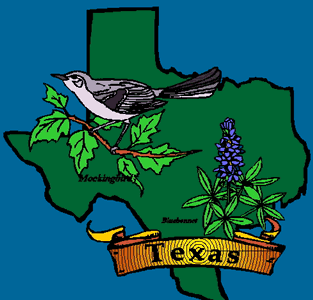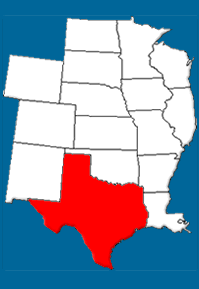 History:
The first Europeans to visit Texas were from Spain. The Spanish governor of Jamaica gave Alonso Alvarez de Pineda four ships and 270 men, and ordered him to look for gold or other wealth. He and his crew were the first to explore the coast of Texas around 1519. Panfilo de Narvaez, also from Spain, came to the coast of Texas in 1528, having been blown off course in a storm. Four members of his party of exploration survived for nearly seven years in Texas, and it was their reports of the land and native people that led Spain to sponsor Francisco Vazquez de Coronado in his overland expedition through New Mexico and Texas. He reached the panhandle area of West Texas in 1541.
The next recorded contact by Europeans came in 1554 as a result of three Spanish ships wrecked off Padre Island. Perhaps 250 of the survivors were killed by hostile Indians, but a few escaped by boat and one on foot. Knowledge of the wrecks, laden with gold and silver, prompted salvage operations from Veracruz and Tampico in the late summer of that same year. Although early explorations yielded little of the reported mountains of gold that were rumored to exist in the New World, eventually, rich silver deposits were discovered in Northern Mexico in 1546, and settlers came to the area in greater and greater numbers to exploit these resources.
Aside from those coming to the area in search of riches, the other main reason for Europeans to come to the area was to bring the Christian religion to the native people. Spanish missionaries, specifically the Franciscans, began to establish mission communities in Texas in the late 16th century.
In the next 100 years, the Spanish began to be concerned about the increasing presence and influence of the French, who were also exploring in the region. French explorers like Rene Robert Cavelier, Sieur de La Salle were leading expeditions up and down the Mississippi River, and realized that if the Spanish closed off access to the mouth of that great river, an important trading pathway to French lands further north up to Canada would be jeopardized. Although the Spanish guarded their claim to the area that is now Texas, there was not widespread settlement there.
The Louisiana Purchase in 1803 brought the borders of the United States to Spanish-controlled Texas. In 1813 and 1819 American explorers made initial forays into Texas, and 1821, Moses Austin got a colonization grant from Spanish authorities in San Antonio. Although he did not live long enough to establish a settlement, his son, Stephen Austin brought 300 families across the borders, and started the first American settlement in Texas. At the same time, Mexico had earned its independence from Spain, and was now eager to encourage profitable colonies in Texas. Large numbers of Americans began to cross the border, and by 1830, Americans outnumbered Mexicans in the area.
Although Mexico had, at first, encouraged settlement, the Mexican government began to become concerned about the growing American influence. Politically unstable itself, the Mexican government made periodic attempts to stop American settlement. They also resisted a petition for Texas to become an independent state within the country of Mexico. However, in 1835, a revolution broke out in Texas, and American settlers drove out all Mexican troops, declared independence, and elected their own president. A Mexican army, led by Santa Ana, attempted to re-take Texas, but was eventually defeated by Texan troops under the leadership of Samuel Houston.
Initially, the people of Texas appealed to the United States to be annexed, but there was widespread opposition to the addition of another slave state to the Union, given the already tense political situation over the issue of slavery. Texas remained an independent country for ten years, with Sam Houston twice serving as President. Eventually, however, US Southerners pressed for the addition of Texas to the U.S., and in July, 1845, Texas was formally annexed. This action sparked war with Mexico.
The Civil War in the US brought Texas under yet another flag: that of the Confederacy. After the Civil War, Texas was readmitted to the Union in 1870, after ratifying the Thirteenth, Fourteenth, and Fifteenth Amendments to the Constitution.
The spread of railroads throughout Texas brought widespread farming to the area, but the discovery of oil in 1901 began a slow change to a more industrialized, urban economy for the state. |









